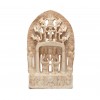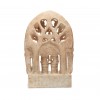
Pair of Bodhisattvas in the Pensive Pose

Photography by Synthescape, Digital image © Asia Society

Photography by Synthescape, Digital image © Asia Society
Pair of Bodhisattvas in the Pensive Pose
Dated 570
China, Hebei Province
Marble
H. 24 1/2 x W. 14 1/2 x D. 5 1/2 in. (62.2 x 37.8 x 14 cm)
Asia Society, New York: Estate of Blanchette Hooker Rockefeller, 1992.4
Licensing inquiries
Crowned figures seated on high stools in mirror-image poses appear in a number of northern Chinese Buddhist reliefs from the second half of the 6th century, and were most likely inspired by works translated by Indian monks in the Chinese court. The two central bodhisattvas are seated in what is often called a "pensive pose," with the forefinger of one hand raised to the cheek, a pose first seen in early Indian Buddhist art from Gandhara and Mathura. The meaning of these steles is not fully understood but it is thought that they represent bodhisattvas seated in a paradise, possibly the Tushita Pure Land of the Bodhisattva Maitreya. The belief that every bodhisattva inhabits the Tushita Pure Land before his final rebirth on earth is found in several early texts that were influential in early Chinese Buddhist thought.


